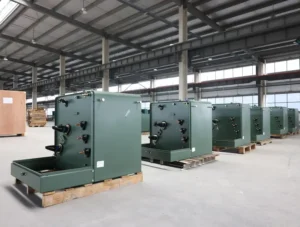The Ultimate Guide To Transformer Rating

How much do you know about transformers? The structure of transformers is very complex. Do you know how to choose the voltage rating and power rating of the transformer? Today, DAELIM will take you to learn about transformer knowledge-transformer ratings.
DAELIM is famous in the transformer field. Because we have rich production experience. And high-quality products-IEEE/CSA/ANSI standards and EEL certification can be reliable. If you have any questions. Don’t hesitate, feel free contact DAELIM.
Small-substastion Transformer
Single Phase Pole Mounted Transformer
Oil Immersed Power Transformer
Table of Content
What are the rated data of the transformer?
Rated capacity (apparent power) Sπ, in VA or KV, refers to the apparent power output by the transformer under rated operating conditions; rated voltage (line voltage) U1N/U2N, in V or KV, where U1N is the primary winding Rated voltage, U2lV is the rated voltage of the secondary winding, which means the voltage of the primary winding when the voltage is U1N and not when the winding is open. Rated current (line current) I1N/I2N, unit is A; (line current) I1N/I2N, unit is A;
Learn more: The Ultimate Guide To 1250 kVA Transformer
How do you read a transformer rating?
The rated voltage of its primary side winding and secondary side winding should be determined according to the following conditions.
For the primary winding of the transformer, its rated voltage is divided into two cases:
(1) When the transformer is directly connected to the generator, the rated voltage of the primary side winding is the same as the rated voltage of the generator, and needs to be 5% higher than the grid voltage of the same level.
(2) When the transformer is directly connected to the urban power grid, the rated voltage of its primary winding is the same as that of the urban power grid.
For the secondary winding of the transformer:
It is necessary to consider the voltage drop of the transformer itself (5%) and the voltage drop of the same-level power supply line of the secondary winding (5%), so the rated voltage of the secondary winding of the transformer is 10% higher than the rated voltage of the grid at the same level; if When the power supply radius of the transformer is small, and the voltage drop of the power supply line can be ignored, the rated voltage of the secondary winding of the transformer can be 5% higher than the rated voltage of the grid at the same level to compensate for the voltage loss of the transformer itself.
Try for free: The Ultimate Guide to 300kVA Pad Mounted Transformer
Transformer power rating, the difference between KVA and KW
Both are units of power, and both are the result of voltage x current. However, the meanings of the two are quite different. Regardless of the engine, motor, or generator. The output is active power, and the unit of active power is KW; In the process of generating electricity, in addition to generating active electric energy for output (including loss). The generator can also adjust the output of the generator by adjusting the phase relationship between current and voltage output reactive power, and provide reactive current for the load (mainly used for transformers and motors to establish magnetic fields).
Therefore, the electrical power output by the generator includes active power (P: unit KW) and reactive power (Q: unit KVar), commonly known as apparent power (S: unit KVA), and the relationship between them is S² =P²+Q².
Generally speaking, the capacity of the power system is mainly described by apparent power, that is to say, the unit is kVA; the active power part is used for the motor and converted into mechanical energy to do work, and the active power unit of this part is expressed in kW. Part of the current is called active current; another part of the current is used for the excitation of transformers and motors, called reactive current, which is used for transformers and motors to establish a magnetic field and provide a “platform” for power transmission or transformation. Work power, expressed in kvar. So kW is “contained” in kVA, and kvar is also “contained”.
There is a phase difference between the active current and the reactive current, so there is a phase difference between the voltage and current of the system, which is the reason for the power factor (cosφ) of the system. P=S×cosφ, Q=S×sinφ. The larger the cosφ, the larger the kW contained in the kVA of the system, which is why the system improves the power factor.
How does the transformer capacity kVA convert to KW?
The current should be calculated according to the resistance, conductivity, line distance and power factor. It can only be estimated approximately, and then according to the current calculation method of the transformer, the estimated current capacity can meet your requirements. Transformer capacity Calculate the total capacity and how much transformer is needed. Transformer capacity required: S (apparent power)=1.732*0.4*399=276.4KVA
The load rate of the long-term operation of the transformer should not exceed 85%, generally controlled at 70%-80%, and the power factor after compensation can generally reach 0.95, but the transformer allows short-term overload. The overload capacity of oil transformers is stronger than that of dry transformers. In the event of an accident, 120% load of dry change can run for 1 hour, and 130% load of oil change can run for 2 hours.
Namely: β=S/Se In the formula: S—calculated load capacity (kVA); Se—transformer capacity (kVA); β—load rate (usually 80% 90%) The on-site electric current is known, how to choose the transformer capacity. 1.7321*line voltage*phase current=transformer capacity, in KVA.
For example: the power factor cosΦ=0.8, the active power is P=1kW. Then tanΦ=0.75, so the square of the apparent power S=the square of P+P*tanΦ square. That is, S=1.25kVA. When the power factor is 1, 1kVA=1kW, 1MVA=1000kVA.
learn more: The Ultimate Guide To Transformer Designs
Transformer capacity power rating selection
The choice of transformer capacity power rating is a comprehensive and always honored technical issue, and there is no simple formula to express it. The selection of transformer capacity is related to factors such as load type and characteristics, load rate, demand rate, power factor, transformer active and reactive power loss, electricity price, infrastructure investment, service life, transformer depreciation, maintenance cost, and future plans.
There are also several ways of transformer selection. For example: capacity selection, form selection, number selection, insulation selection, voltage selection, and impedance selection.
Daelim’s technical team has more than 20 years of international standard design experience. Help you carry out the most economical and applicable transformer solution for the selection, capacity, and technical requirements of the transformer.
Get it now: Transformers Selection and Buying Guide
Transformer power rating calculation
First, select the rated voltage of the transformer, the voltage of the high-voltage side is equal to the voltage of the connected grid, and the voltage of the low-voltage side is 10% or 5% higher than the voltage of the grid on the low-voltage side (depending on the voltage level and impedance voltage of the transformer); rated capacity selection.
Calculate the size of the load carried by the transformer (it is required to count the maximum comprehensive load, and convert the KW value of the active load into the apparent power KVA). If there are two transformers, the capacity of each transformer can be selected according to 70% of the maximum comprehensive load. The transformer should be considered according to the total load, and leave an appropriate margin. Others, the nameplate parameters should be
Properly considered in combination with the transformer products.
For example: choose a 35/10kV transformer. Assuming that the maximum load is 3500kW, the power factor is 0.8, two transformers are selected, the capacity S=0.7×3500/0.8=3062kVA, and the transformer of 3150kVA can be selected, and the voltage ratio is 35kV/10.5kV. Then select the model number from the product catalog
The formula for calculating the rated current of the transformer
3150KVA transformer rated current: Primary side current: I+P/1.732/35=52A, secondary side current at 0.4KV: I=3150/1.732/0.4=4547A
According to the power is equal to the voltage multiplied by the current, the current is equal to the power divided by the voltage, and the result can be calculated. 1250KVA three-phase power transformer, its rated voltage is 380V, then the rated current I=P/V=1250/380/1.73. The result is 1900A.
Function and application of transformer in life
Generally speaking, electricity plays a vital role in our daily life. With the development of the world economy and the development of science and technology, we are increasingly inseparable from electricity, which supports people’s life and work. It provides us with convenience. As a result, the status of the transformer is also increasing. Not only the required quantity but also the required quantity and good performance.
Modern industrial enterprises widely use electricity as energy, and the power of power plants often needs to be transmitted to power-consuming areas. When the transmitted power is constant, the higher the transmission voltage, the smaller the current required.
Because the voltage drop is proportional to the current 12R. The line is proportional to the square of the current, so a higher transmission voltage can obtain a lower line voltage drop and line loss. It is difficult to manufacture a generator with high voltage, so special equipment is required.
After the voltage at the generator end is raised, it is sent out. This special equipment is a transformer. On the other hand, at the power receiving end, the high voltage must be reduced to the voltage of the distribution system by a step-down transformer. Therefore, the high voltage must be reduced to an appropriate value through a series of distribution transformers for use
You may enjoy: How to produce a distribution transformer?
Daelim have more than 15 years experience in transformer manufacture field. With IEEE/CSA/ANSI standards and UL/cUL certified can providing. Wide range voltage can for your choose. Daelim transformer rating for the standard transformer. If you have any question about transformer rating, welcom to consult DAELIM. Feel free contanct us.











